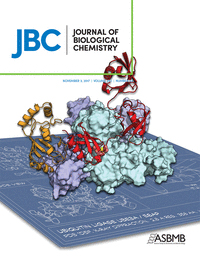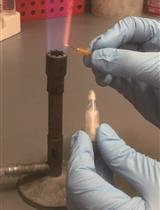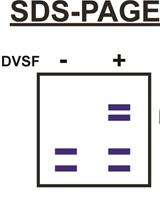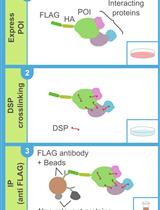- EN - English
- CN - 中文
An Improved Method for Measuring Chromatin-binding Dynamics Using Time-dependent Formaldehyde Crosslinking
一种改进的使用时间依赖性甲醛交联测定染色质结合动力学的方法
发布: 2018年02月20日第8卷第4期 DOI: 10.21769/BioProtoc.2905 浏览次数: 9543
评审: Gal HaimovichAnonymous reviewer(s)
Abstract
Formaldehyde crosslinking is widely used in combination with chromatin immunoprecipitation (ChIP) to measure the locations along DNA and relative levels of transcription factor (TF)-DNA interactions in vivo. However, the measurements that are typically made do not provide unambiguous information about the dynamic properties of these interactions. We have developed a method to estimate binding kinetic parameters from time-dependent formaldehyde crosslinking data, called crosslinking kinetics (CLK) analysis. Cultures of yeast cells are crosslinked with formaldehyde for various periods of time, yielding the relative ChIP signal at particular loci. We fit the data using the mass-action CLK model to extract kinetic parameters of the TF-chromatin interaction, including the on- and off-rates and crosslinking rate. From the on- and off-rate we obtain the occupancy and residence time. The following protocol is the second iteration of this method, CLKv2, updated with improved crosslinking and quenching conditions, more information about crosslinking rates, and systematic procedures for modeling the observed kinetic regimes. CLKv2 analysis has been applied to investigate the binding behavior of the TATA-binding protein (TBP), and a selected subset of other TFs. The protocol was developed using yeast cells, but may be applicable to cells from other organisms as well.
Keywords: Chromatin immunoprecipitation (ChIP) (染色质免疫沉淀(ChIP))Background
Transcription initiation is a complicated process that involves the cooperation and coordinated interaction of dozens of proteins on a chromatinized promoter (Kim et al., 2005; Encode Consortium, 2012; Rhee et al., 2012; Dowen et al., 2014). Many studies have investigated the assembly and regulation of the core transcriptional machinery in vitro (Zawel and Reinberg, 1992; Conaway and Conaway, 1993; Roeder, 1996; Hager et al., 2009; He et al., 2013; Cramer, 2014; Luse, 2014; Horn et al., 2016), but it has been more challenging to examine the stochastic nature of these processes in vivo. There are two general approaches used to measure chromatin-binding dynamics in vivo: microscopy and ChIP-based techniques (Coulon et al., 2013; Mueller et al., 2013). Microscopic techniques, such as fluorescence recovery after photobleaching (FRAP) or single molecule tracking (SMT), have high temporal resolution and have provided fundamental insight into chromatin binding dynamics, including results obtained by tracking individual molecules (Larson et al., 2009; Mueller et al., 2013; Morisaki et al., 2014). However, these approaches can be limited by photophysical effects such as photobleaching, and in addition, in the great majority of cases it is not possible to determine the identity of particular single copy loci where the measured interactions occur (Mueller et al., 2013). Alternatively, ChIP-based approaches provide precise chromatin location information. In Competition ChIP (CC), expression of a differentially tagged isoform of the TF of interest is induced and the relative levels of the constitutive and induced forms of the TF are monitored over time, yielding binding kinetic information through measurements of TF turnover at the sites of interest (van Werven et al., 2009; Lickwar et al., 2013). With advancements in modeling of CC data, residence times as short as 1.3 min have been measured (Zaidi et al., 2017). Relative dynamic measurements have also been made by conditional depletion of TFs from the nucleus using the Anchor Away technique (Haruki et al., 2008; Grimaldi et al., 2014), although specific mathematical models of the process have not yet been reported. The CLK method is complementary to these other ChIP-based approaches, exploiting the time dependence of formaldehyde crosslinking to derive binding kinetic parameters as well as fractional occupancy (Poorey et al., 2013). The first iteration of the CLK assay used ‘standard’ crosslinking and quenching conditions (1% formaldehyde and 250 mM glycine, respectively). Additional work has recently yielded experimental conditions that increase the crosslinking rate and improve quenching of the crosslinking reaction (Zaidi et al., 2017). These new conditions have resulted in a more robust method and the ability to model and analyze crosslinking kinetic data with more reliability and confidence.
Materials and Reagents
- Pipette tips
- Reusable cotton-plug top serological (glass) pipettes (can also use single-use plastic pipettes)
10 ml pipettes (Fisher Scientific, catalog number: 13-675M )
25 ml pipettes (Fisher Scientific, catalog number: 13-675N ) - Pipette sterilizing boxes (Fisher Scientific, catalog number: 03-465 )
- Nalgene PPCO centrifuge bottles with sealing closure (Thermo Fisher Scientific, Thermo ScientificTM, catalog number: 3141-0500 )
- 50 ml conical tubes 30 x 115 mm (Corning, Falcon®, catalog number: 352070 )
- 2.0 ml microcentrifuge conical screw cap tubes (FastPrep tubes, Fisher Scientific, catalog number: 02-681-344 )
- Microcentrifuge tube screw caps with O-Rings (for FastPrep tubes, Fisher Scientific, catalog number: 02-681-366 )
- Acid washed 425-600 μm glass beads (Sigma-Aldrich, catalog number: G8772 )
- 18 gauge needle (PrecisionGlide, BD, catalog number: 305195 )
- Disposable culture tubes, glass 13 x 100 mm (Fisher Scientific, catalog number: 14-961-27 )
- 1.5 ml microcentrifuge tubes graduated (Fisher Scientific, catalog number: 05-408-129 )
- Whatman filter paper (GE Healthcare, catalog number: 1003-917 )
- Autoradiography film (Genesee Scientific, catalog number: 30-101 )
- 1.5-1.7 ml polypropylene graduated tube with locking lid (Fisher Scientific, catalog number: 02-681-285 )
- Hard-Shell High-Profile 96-well semi-skirted PCR plates (Bio-Rad Laboratories, catalog number: HSS9641 )
- Tubular roll stock (to seal membrane in plastic before developing; Ampac, catalog number: TRS-95125-3 )
- Immobilon-P membrane (PVDF; Merck, catalog number: IPVH00010 )
- Microseal ‘B’ seal seals (Bio-Rad Laboratories, catalog number: MSB1001 )
- Stericup sterile vacuum filter units, 500 ml (Merck, catalog number: SCGPU05RE )
- Yeast strains, wild type (WT) and overexpression (OE) for each TF of interest (see Poorey et al., 2013 and Zaidi et al., 2017 for strain lists)
- Plasmids for TF overexpression and vector control for WT strain (see Poorey et al., 2013 and Zaidi et al., 2017 for plasmid lists)
- Locus specific primers (Invitrogen)
- In-Fusion HD cloning kit (Takara Bio, Clontech, catalog number: 639649 )
- Ice bucket
- 37% formaldehyde (Fisher Scientific, catalog number: F79 )
- Protein Assay Dye Reagent Concentrate (Bio-Rad Laboratories, catalog number: 500-0006 )
- nProtein A Sepharose 4 Fast Flow beads (GE Healthcare, catalog number: 17-5280-01 )
Note: Ab-conjugated beads can be used instead, such as IgG Sepharose 6 Fast Flow (GE Healthcare, catalog number: 17-0969-01 ) and Sepharose 6 Fast Flow beads (GE Healthcare, catalog number: 17-0159-99 ). - QIAQuick PCR purification kit (QIAGEN, catalog number: 28106 )
- iQ SYBR Green Supermix, 500 x 50 μl rxns (Bio-Rad Laboratories, catalog number: 1708882 )
- Instant non-fat dry milk (Carnation)
- Antibody (i.e., α-TBP, monoclonal, Abcam, catalog number: ab61411 )
- Secondary ECL-conjugated antibody (we use Amersham ECL mouse or rabbit IgG HRP-linked whole Ab, GE Healthcare, catalog numbers: NXA931 or NA934V )
- Amersham ECL Prime Western blotting detecting reagent (GE Healthcare, catalog number: RPN2232 )
- Yeast extract (BD, BactoTM, catalog number: 212750 )
- Bacto peptone (BD, BactoTM, catalog number: 211677 )
- Sugar source, i.e.,:
D-(+)-Glucose (Sigma-Aldrich, catalog number: G7021 )
D-(+)-Galactose (Sigma-Aldrich, catalog number: G5388 )
D-(+)-Raffinose (MP Biomedicals, catalog number: 02102797 ) - Difco yeast nitrogen base without amino acids and ammonium sulfate (BD, DifcoTM, catalog number: 233520 )
Note: Yeast nitrogen base without amino acids (with or without sugar source) can be used as an alternative and doesn’t require the addition of ammonium sulfate (i.e., Sigma-Aldrich, catalog number: Y0626 ). - Amino acids:
- Adenine hemisulfate dihydrate (MP Biomedicals, catalog number: 02100195 )
- L-Histidine hydrochloride monohydrate (Acros Organics, catalog number: 411731000 )
- L-Lysine (Fisher Scientific, catalog number: BP386 )
- L-Tyrosine (Acros Organics, catalog number: 140641000 )
- L-Tryptophan (Fisher Scientific, catalog number: BP395 )
- Uracil (Affymetrix, catalog number: 23020 )
- L-Leucine (Acros Organics, catalog number: 125121000 )
- L-Methionine (Fisher Scientific, catalog number: BP388 )
- L-Arginine hydrochloride (Fisher Scientific, catalog number: BP372 )
- L-Serine (Fisher Scientific, catalog number: BP393 )
- Valine (Fisher Scientific, catalog number: BP397 )
- L-Threonine (MP Biomedicals, catalog number: 02103053 )
- L-Isoleucine (Fisher Scientific, catalog number: BP384 )
- L-Phenylalanine (Fisher Scientific, catalog number: BP391 )
- L-Cysteine hydrochloride monohydrate (Fisher Scientific, catalog number: BP376 )
- L-Aspartic Acid (Acros Organics, catalog number: 105041000 )
- L-Proline (Fisher Scientific, catalog number: BP392 )
- Adenine hemisulfate dihydrate (MP Biomedicals, catalog number: 02100195 )
- Bacto agar (BD, catalog number: 214010 )
- Glycine, 2 kg (Bio-Rad Laboratories, catalog number: 1610724 )
- Hydrochloric acid (Fisher Scientific, catalog number: A144SI-212 )
- Tris base (Sigma-Aldrich, catalog number: T1503 )
- Ammonium sulfate (Sigma-Aldrich, catalog number: A4418 )
- Magnesium chloride hexahydrate (Sigma-Aldrich, catalog number: M9272 )
- EDTA (Fisher Scientific, catalog number: BP120 )
- Glycerol (Fisher Scientific, catalog number: BP229 )
- β-Mercaptoethanol (Sigma-Aldrich, catalog number: M3148 )
- Protease inhibitors
cOmplete protease inhibitor tablet EDTA-free (Roche Diagnostics, catalog number: 04693132001 )
OR:
Phenylmethylsulfonyl fluoride (Sigma-Aldrich, catalog number: P7626 )
Benzamidine hydrochloride hydrate (Acros Organics, catalog number: 105241000 )
Pepstatin A (Sigma-Aldrich, catalog number: P4265 )
Leupeptin hemisulfate salt (Sigma-Aldrich, catalog number: L8511 )
Chymostatin (Sigma-Aldrich, catalog number: C7268 ) - SDS (Sigma-Aldrich, catalog number: L3771 )
- DTT (Roche Diagnostics, catalog number: 03117006001 )
- Bromophenol blue (Bio-Rad Laboratories, catalog number: 1610404 )
- Coomassie blue
- Methanol (Fisher Scientific, catalog number: A452 )
- Acetic acid
- Sodium chloride (Fisher Scientific, catalog number: S640 )
- Tween 20 (Sigma-Aldrich, catalog number: P5927 )
Note: This product has been discontinued. - HEPES (Fisher Scientific, catalog number: BP310 )
- Triton X-100 (AMRESCO, catalog number: 0694 )
- Sodium deoxycholate (Sigma-Aldrich, catalog number: D6750 )
- Lithium chloride (Sigma-Aldrich, catalog number: L4408 )
- Nonidet P40 (Spectrum, catalog number: N1156 )
Note: This product has been discontinued. - Diethyl pyrocarbonate (DEPC), 97% pure (Acros Organics, catalog number: 170250250 )
- Acrylamide (Bio-Rad Laboratories, catalog number: 1610101 )
- Bis-acrylamide (Fisher Scientific, catalog number: BP171 )
- Ammonium persulfate (APS, Bio-Rad Laboratories, catalog number: 1610700 )
- TEMED (Thermo Fisher Scientific, Thermo ScientificTM, catalog number: 17919 )
- YPD media (see Recipes)
- 30% raffinose or galactose (see Recipes)
- SC media (Yeast synthetic media, see Recipes)
- Amino acid mix (see Recipes)
- 3 M glycine quench solution (see Recipes)
- Benoit’s buffer (see Recipes)
- Laemmli buffer (4x sample buffer, see Recipes)
- Coomassie stain (see Recipes)
- TBS (see Recipes)
- TBST (see Recipes)
- 140 mM ChIP lysis buffer (see Recipes)
- 500 mM ChIP lysis buffer (see Recipes)
- LiCl wash buffer (see Recipes)
- 1x TE (see Recipes)
- ChIP elution buffer (see Recipes)
- DEPC H2O (see Recipes)
- 30%/0.8% Bis-acrylamide solution (see Recipes)
- SDS-PAGE running buffer (see Recipes)
- Transfer buffer (see Recipes)
Equipment
- Glass culture tubes and caps, 18 x 150 mm (i.e., disposable borosilicate glass tubes with plain end, Fisher Scientific, catalog number: 14-961-32 and Diamond culture tube caps, 18 mm, Globe Scientific, catalog number: 118154 )
- Flasks (1 L, 250 ml; i.e., Pyrex narrow-neck heavy-duty glass Erlenmeyer flasks, Corning, PYREX®, catalog numbers: 4980-1L (1L) and 4980-250 (250 ml))
- Pipettes (P2, P2, P200, P1000)
- Pipet-Aid (Drummond Scientific, catalog number: 4-000-100 )
- Incubator, 30 °C (i.e., Isotemp CO2 incubator, Fisher Scientific, Fisherbrand, catalog number: 11-676-603 )
- Magnetic stir bars (Fisher Scientific, catalog number: 14-513-52 )
- Stirring hot plate (Fisher Scientific, catalog numbers: 11-510-49SH or SP88850200 )
- Timer
- Sorvall RC 5B centrifuge (GMI, model: Sorvall RC-5B )
- SLA-3000 rotor (Thermo Fisher Scientific, Thermo ScientificTM, model: SLA-3000 , catalog number: 07149)
- Eppendorf 5810 R benchtop centrifuge with plate buckets and 15 ml/50 ml adapters (Eppendorf, model: 5810R , catalog number: 5811000827)
- MP FastPrep-24 Bead beater (MP Biomedicals, model: FastPrep®-24 Classic, catalog number: 116004500 )
- Bunsen burner
- Branson Sonifier 250 with 1/8” microtip probe (Fisher Scientific, catalog numbers: 22-309782 and 22-309796 )
- Eppendorf 5415C or D benchtop centrifuge (Eppendorf, similar is catalog number: 022620304 )
- Shaker, 30 °C (i.e., Eppendorf, New Brunswick Scientific, model: Excella® E25 , catalog number: M1353-0002)
- 4 °C refrigerator
- -20 °C freezer
- -80 °C freezer
- Autoclave
- AutoMixer magnetic stir plate (Fisher Scientific, catalog number: 14-505-21 )
- Ultrospec 2100pro UV/Visible spectrophotometer (Biochrom, model: ULTROSPEC 2100® , catalog number: 80-2112-21)
- PowerPac Basic power supply (Bio-Rad Laboratories, catalog number: 1645050 )
- Mini-PROTEAN tetra cell with casting stand and frames, combs, short plates, and spacer plates (Bio-Rad Laboratories, catalog number: 1658006FC )
- Mini trans-blot electrophoretic transfer cell with holder cassettes, foam pads, and blue cooling unit (Bio-Rad Laboratories, catalog number: 1703930 )
- Shaker (Reliable Scientific, model: 55S )
- Autoradiography cassette (Fisher Biotech, catalog number: FBXC 810 )
- Labquake shaker rotisserie, 32 x 10 to 19 mm with clip bar (Thermo Fisher Scientific, Thermo ScientificTM, catalog number: 415110Q )
- Water baths (55 °C and 65 °C)
- MyiQ real-time instrument (Bio-Rad Laboratories, catalog number: 170-9770 )
Software
- ImageJ (NIH)
- Mathematica
- R or R-Studio
Procedure
文章信息
版权信息
© 2018 The Authors; exclusive licensee Bio-protocol LLC.
如何引用
Readers should cite both the Bio-protocol article and the original research article where this protocol was used:
- Hoffman, E. A., Zaidi, H., Shetty, S. J., Bekiranov, S. and Auble, D. T. (2018). An Improved Method for Measuring Chromatin-binding Dynamics Using Time-dependent Formaldehyde Crosslinking. Bio-protocol 8(4): e2905. DOI: 10.21769/BioProtoc.2905.
- Zaidi, H., Hoffman, E. A., Shetty, S. J., Bekiranov, S. and Auble, D. T. (2017). Second-generation method for analysis of chromatin binding with formaldehyde-cross-linking kinetics. J Biol Chem 292(47): 19338-19355.
分类
分子生物学 > DNA > DNA-蛋白质相互作用
生物化学 > 蛋白质 > 相互作用 > 交联
您对这篇实验方法有问题吗?
在此处发布您的问题,我们将邀请本文作者来回答。同时,我们会将您的问题发布到Bio-protocol Exchange,以便寻求社区成员的帮助。
Share
Bluesky
X
Copy link













